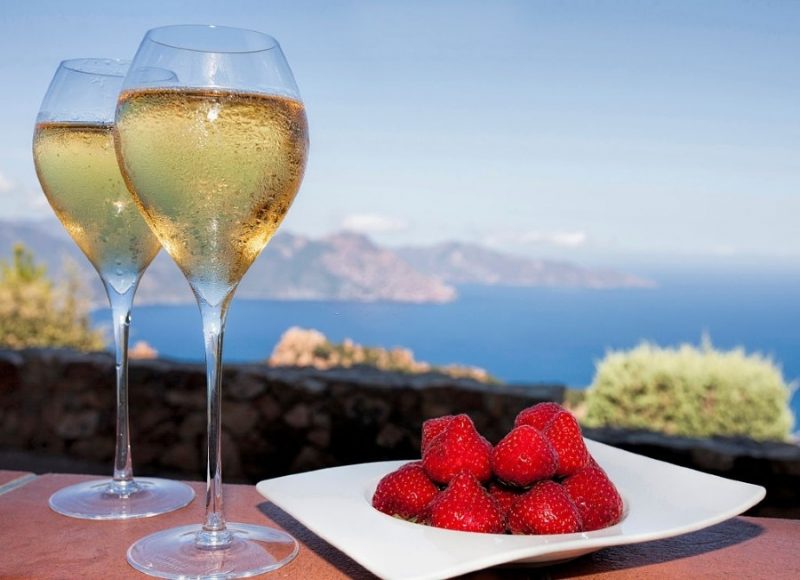Dessert wines are perfect for enhancing the end of a meal in harmony with sweet treats. Their aromatic richness, sweetness and intensity vary according to grape variety and winemaking technique. This article explores the best dessert pairings, types of sweet wine, and tips for a successful taste experience.
What is a dessert wine?
1. Natural softness
Dessert wines are wines with a high residual sugar content. This sugar comes from grapes harvested at advanced maturity.
2. Specific winemaking techniques
- Late harvest: The grapes remain on the vines to develop concentrated sugars.
- Botrytis cinerea: This noble rot enriches the aromas and complexity of sweet wines.
- Barrel aging: Some wines, like Sauternes, gain in depth from prolonged aging.
3. A wide range of styles
Dessert wines range from mellow whites to sweet reds, offering options for every type of sweetness.
The main types of dessert wine

1. Sweet wines
These sweet, rich, unctuous wines go well with complex desserts.
- Examples: Sauternes, Tokaji, Muscat de Beaumes-de-Venise.
- Pairings: Lemon meringue pie, crème brûlée, fruity desserts.
2. Sweet wines
Lighter than sweet wines, they go well with simple, delicate sweets.
- Examples: Coteaux du Layon, sweet Riesling, Gewurztraminer.
- Pairings: Fruit cakes, shortbread, spiced desserts.
3. Sweet sparkling wines
These sparkling wines bring freshness and lightness to the end of a meal.
- Examples: Moscato d'Asti, Champagne demi-sec, sweet Prosecco.
- Pairings: Panna cotta, fresh fruit, white chocolate desserts.
4. Sweet red wines
Their rich, fruity character complements chocolate and red fruit desserts.
- Examples: Banyuls, Porto Ruby, Recioto della Valpolicella.
- Pairings: Chocolate fondant, cherry pie.
How to pair dessert wines with sweets?
1. Harmonizing softness
A dessert that's too sweet can overwhelm a wine that's too light. Make sure the wine is at least as sweet as the dessert.
2. Playing on contrasts
Tart desserts, such as lemon tart, are well balanced with a smooth, rounded wine.
3. Respecting aromas
Pair wines with complementary aromas to bring out the full flavors.
- Example: A Sauternes with crème brûlée, for its notes of honey and vanilla.
The best dessert pairings by wine type
1. Dark chocolate
Dark chocolate, with its intensity and bitterness, requires a powerful, sweet wine.
- Recommended wines: Banyuls, Porto, Vin Santo.
- Related dishes: Chocolate fondant, dark chocolate mousse.
2. Fruity desserts
Fruit-based desserts go well with light, fresh wines.
- Recommended wines: Moscato d'Asti, sweet Riesling, Muscat.
- Related dishes: Fruit salad, strawberry tart.
3. Cream-based pastries
Creams and mousses require smooth, well-balanced wines.
- Recommended wines: Sauternes, Tokaji, Gewurztraminer.
- Related dishes: Tiramisu, panna cotta.
4. Cheeses
Some cheeses, such as Roquefort, go wonderfully well with sweet wines.
- Recommended wines: Sauternes, sweet Jurançon.
- Matching dishes: Cheese platter, blue cheese.
Tips for tasting dessert wines
1. Serve at the right temperature
- Sweet white wines: 8-10 °C.
- Sweet red wines: 12-14 °C.
- Sparkling wines: 6-8 °C.
2. Use appropriate lenses
Use white wine glasses to concentrate aromas.
3. Limit quantities
Dessert wines are often rich. A small quantity is enough to appreciate their qualities.
Common mistakes to avoid
1. Neglect the operating temperature
A wine that's too cold masks its aromas, while one that's too warm becomes heavy.
2. Ignore sugar content
A wine that is too dry contrasts badly with a sweet dessert. Choose well-balanced wines.
3. Offer only one type of wine
Vary the styles to suit the diversity of desserts served.
Dessert wine trends
1. Back to local traditions
Enthusiasts are rediscovering old appellations such as Jurançon and Vin de Paille.
2. Interest in natural wines
Natural dessert wines, made using traditional methods, are gaining in popularity.
3. Experimentation with innovative agreements
Chefs and sommeliers are exploring daring pairings, such as sweet wines with savory or spicy dishes.
Conclusion: dessert wines to enhance your sweets
Dessert wines, whether sweet, syrupy or sparkling, add a refined finishing touch to your meals. By mastering dessert pairings and choosing the right sweet wine, you can offer your guests an unforgettable experience. Take the time to explore these pairings and discover new styles to enrich your passion for wine.
If you enjoyed this article, please read the following article "How to prepare a wine tasting at home", which may also be of interest to you!





